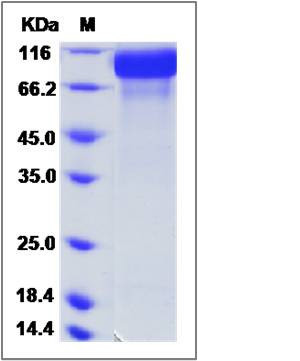Cynomolgus HER2 / ErbB2 Protein (His Tag)
ERBB2
- 100ug (NPP1261) Please inquiry
| Catalog Number | P90295-C08H |
|---|---|
| Organism Species | Cynomolgus |
| Host | Human Cells |
| Synonyms | ERBB2 |
| Molecular Weight | The recombinant cynomolgus ERBB2 comprises 641 amino acids and has a calculated molecular mass of 70.8 KDa. The apparent molecular mass of it is approximately 80-105 KDa in SDS-PAGE under reducing conditions. |
| predicted N | Thr 23 |
| SDS-PAGE |  |
| Purity | > 90 % as determined by SDS-PAGE |
| Protein Construction | A DNA sequence encoding the cynomolgus ERBB2 (Met1-Thr652) [similar to Macaca fascicularis ERBB2 (EHH58073.1)] was expressed with a polyhistidinetag atthe C-terminus. |
| Bio-activity | Measured by its binding ability in a functional ELISA. Immobilized Cynomolgus ERBB2-His at 10 μg/ml (100 μl/well) can bind Herceptin, The EC50 of Herceptin is 16.4-38.4 ng/ml. |
| Research Area | Cardiovascular |Angiogenesis |Growth Factor & Receptor |Receptor Tyrosine Kinase (RTK) |
| Formulation | Lyophilized from sterile PBS, pH 7.4. 1. Normally 5 % - 8 % trehalose and mannitol are added as protectants before lyophilization. Specific concentrations are included in the hardcopy of COA. |
| Background | Human epidermal growth factor receptor 2 (HER2), also known as ErbB2, NEU, and CD340, is a type I membrane glycoprotein, and belongs to the epidermal growth factor (EGF) receptor family. HER2 protein cannot bind growth factors due to the lacking of ligand binding domain of its own and autoinhibited constitutively. However, HER2 forms a heterodimer with other ligand-bound EGF receptor family members, therefore stabilizes ligand binding and enhances kinase-mediated activation of downstream molecules. HER2 plays a key role in development, cell proliferation and differentiation. HER2 gene has been reported to associate with malignancy and a poor prognosis in numerous carcinomas, including breast, prostate, ovarian, lung cancers and so on. |
| Reference |
